The Mittal Institute’s Fulbright Fellow 2024, Sarah Umer, comes to Cambridge from the University of the Punjab Lahore, where she is an associate professor in the College of Art and Design. Her research includes the study of art, ancient civilizations, and religions, predominantly in the South Asian region. We spoke to Sarah about her previous research and her research plans while in residence at LMSAI.
Mittal Institute: Welcome, Sarah! You recently arrived from Lahore, Pakistan. Is this your first time visiting Cambridge? What has surprised you so far and what are you most looking forward to?
Sarah Umer: Yes, this is my first time in Cambridge, however the way it has been structured is like several European cities. It is well-kept, has less traffic and gives one an invitation to walk around. Nothing has surprised me so far other than the library collections and databases available through HOLLIS. Although, I knew about these but to be able to browse and obtain information from these sources is quite overwhelming. It’s been a month, and I am still trying to explore all the relevant libraries, museum collections and digital databases from where I can get information related to my research. So far, the extent of resources available are beyond comprehension but I do hope to explore them to a certain point.
Mittal Institute: You began your academic career with a Ph.D dissertation on the religious beliefs of the Indus Valley people – a subject with scarce research. What drew you to this topic, and what did you discover?
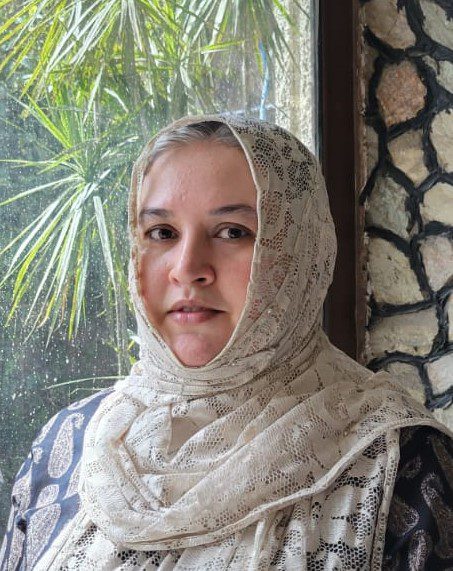
Sarah Umer, LMSAI Fulbright Fellow.
Sarah Umer: The Indus Valley civilization (6500 BC) is among the three ancient civilizations of the world. According to excavations, it is approximately one thousand years later than Mesopotamian civilization (7600 BC) and one thousand years earlier than Egyptian civilization (4500 BC).
There were initially three reasons why I started to probe the religion of this civilization; one was scarce material and lack of commentary, the second was that most Indus scholars and archaeologists had conveniently associated the religion of this civilization with the later indigenous religions of the land (Hinduism, Buddhism and Jainism) and the third and the most important reason was that no scholar had attempted to understand the religious beliefs of the Indus people.
Many of my colleagues and mentors discouraged my choice of topic, as the Indus Valley civilization is among all ancient civilizations the least investigated due to limitation of language, translations, and documents. Therefore, in the absence of a deciphered Indus script, I began my study totally dependent on archaeology. I suspected that my evidence negates the existence of a polytheistic Indus society that was using small figurines as opposed to the very large deities that adorn the temples of its contemporary civilizations.
In my thesis I concluded that the religion of the Indus Valley civilization must be based on concepts of equality and justice, and that they were some of the most important binding forces that allowed its successful continuity for centuries. As evident from the lifestyle of the individual, I traced the rights that each Indus person gave to his fellow citizen. This glorious civilization—geographically double the size of its contemporary civilizations—existed for many centuries without the use of visible force and arms, at a time when its contemporary Mesopotamia and Egypt were busy fighting over territorial gains. The Indus Valley Civilization shows no evidence of production of weaponry at any of the excavated sites.
In my thesis I concluded that the religion of the Indus Valley civilization must be based on concepts of equality and justice, and that they were some of the most important binding forces that allowed its successful continuity for centuries.
Mittal Institute: You have since expanded your research to include much of South Asia. Can you share what project you will focus on while at the Mittal Institute?
Sarah Umer: Today my research includes much of South Asia and the Greater Arab world to discover religious affiliations among texts belonging to a larger geographical area and the hypotheses that Harappans were probably the parent stock of all Mesopotamians.
During my three-month fellowship at University of London, SOAS, I arrived at new possibilities to probe the religious beliefs of the Indus Valley people not only by study of more Sumerian and Akkadian tablets and by study of tablets found from multiple cities of the ancient Arab world, such as at Ebla, Ugarit, Mari, and Egypt. My research into the translations of these tablets indicates a rise of interest in a personal God during the second millennium BCE, while simultaneously the people also believed in several secondary nature gods (Henotheism). According to written record and Biblical references that coincide with Mesopotamian archaeological texts, when Abraham (2000 – 1800 BCE) migrated from Ur with his companions, he left behind all secondary Gods because they had failed the inhabitants. There are indications of abandonments by its city gods in sixteen cities, including Ur, Sumer and Nippur that led to the destruction of these cities,resulting in a general severe religious crisis. However, during their migration, Abraham’s group kept the One God they had worshipped since their birth. This God of their fathers, which according to some scholars only existed in their stories, nonetheless, was one that should be seen as the true essence of being a Sumerian of the time and was taken with them, when they migrated. Moreover, there are other texts, I came across at SOAS that indicate that the Sumerians believed in a chief personal God beside secondary nature gods at least five hundred years before Abraham, thus, pushing back the belief in one personal God into the third millennium BCE.
Many scholars today, including this writer see the Harappans as the parent stock of the Mesopotamians. TheKing James version of the Bible, The First Book of Moses, called Genesis, chapter 11, says that the ancestors of the Hebrews came to the city of Ur from the East; the Bible does not say when Noah and his son Shem with their families arrived in Sumer (Ur), but it does say that they came from the East and they found and built up landscapes of cities and towers. According to some scholars like Geoffrey Bibby, Samuel N. Kramer, Jack Finegan and Nick Wyatt, when we corelate the Bible, Ebla, and Ugarit texts with archaeology of the region it suggests that the region to the east must either be Meluhha (Indus) or Dilmun (Bahrain).
Rigveda, the earliest Vedic scripture of this region, also talks about a personal God, while the Muslim geographer Abu Rehn Alberuni in the 11th AC notes strands of monotheism in the Bhagavad-Gita. Unfortunately, the written history of the Indus region that begins with these Vedic scripture’s dates back only to 1500 – 1200 BCE and coincides with the Ugarit dates and Mari tablets, while the Sumerian, Ebla and Egyptian tablets predate these scriptures. Additionally, Kosambi argues that the Vedic scriptures are not written in pure Aryan and sees earlier non-Aryan grammatical structures and forms in both syntax and vocabulary in them, which strength an argument that the religious history of Indus region might be much older.
Therefore, in the absence of a deciphered Indus script, I plan to consider all textual probabilities to find and recognize the influence of Harappan religious and literary inheritance not only in the early strata of Hinduism but also in the religious thought prevalent in the oral traditions of greater Arab world.
Mittal Institute: What excites you most about this research?
Sarah Umer: The fact that this research could open new avenues in the field of ancient religious history for scholars working on ancient Mesopotamia and South Asia excites me the most and the possibilities that the Indus Valley civilization might be able to gain a recognition on par with or beyond the civilizations of Mesopotamia and Egypt, a recognition it might have earned but never received considering its religious beliefs.
Moreover, this study promises to unearth possibilities that might contribute to the fact that this region was not only home to later indigenous religions like Jainism, Buddhism and Hinduism that helped in shaping the religious beliefs of other regions of South Asia and Southeast Asia but also has a much older presence that could have contributed towards shaping the religious beliefs of the greater Arab world.
The fact that this research could open new avenues in the field of ancient religious history for scholars working on ancient Mesopotamia and South Asia excites me the most.
Mittal Institute: You have also worked to preserve and promote the art of Pakistan. How have you done that, and why is this important to you?
Sarah Umer: There are very few regions in the world who enjoy a legacy as old as my region. However, as Pakistanis there is a lot that needs to be done to celebrate, promote and preserve the art of Pakistan. The presence of Pakistani artists on international forums is scarce, therefore recently I initiated at College of Art and Design a research-based activity that includes seminars and exhibitions on those eminent artists who are alumni of the college and have contributed towards enriching the art of Pakistan. I have made this project part of a research methodology class to instigate in students the love for research. One such activity was held on June 7, 2022, on Prof. Dr Shaukat Mahmood and was executed by MPhil scholars (class of 2021-23).
The exhibited work was based on selective cartoons of Dr Mahmood and are a representation of his impression of various people, society, and the predominant circumstances. The exhibited cartoons have been divided into three genres: Caricatures of Popular Personalities, Awam Ki Halat-E-Zaar and Politics from the Pen. The caricatures are hand drawn while the rest of the cartoons are digital prints that are based on his most recent work.
The seminar was divided into six segments highlighting the distinct facets of Dr. Mahmood’s quest over the decades. These segments included his Early Life, His Contribution as a Cartoonist, His Contribution as an Educationist, His Contribution as a Documentarian, His Contribution as a Book Author and finally His Contribution as a Research and News Article Author. Although the seminar was presided by the MPhil scholars, however, against each segment renowned artists and scholars were invited to shed further light on Dr. Mahmood’s quest. These included Dr. Rafia Tahir, Tariq Mahmood, Dr. Rahat Naveed Masud, Prof. Kamil Khan Mumtaz, Muhammad Javed and Dr. Nadhra Shahbaz Naeem Khan.
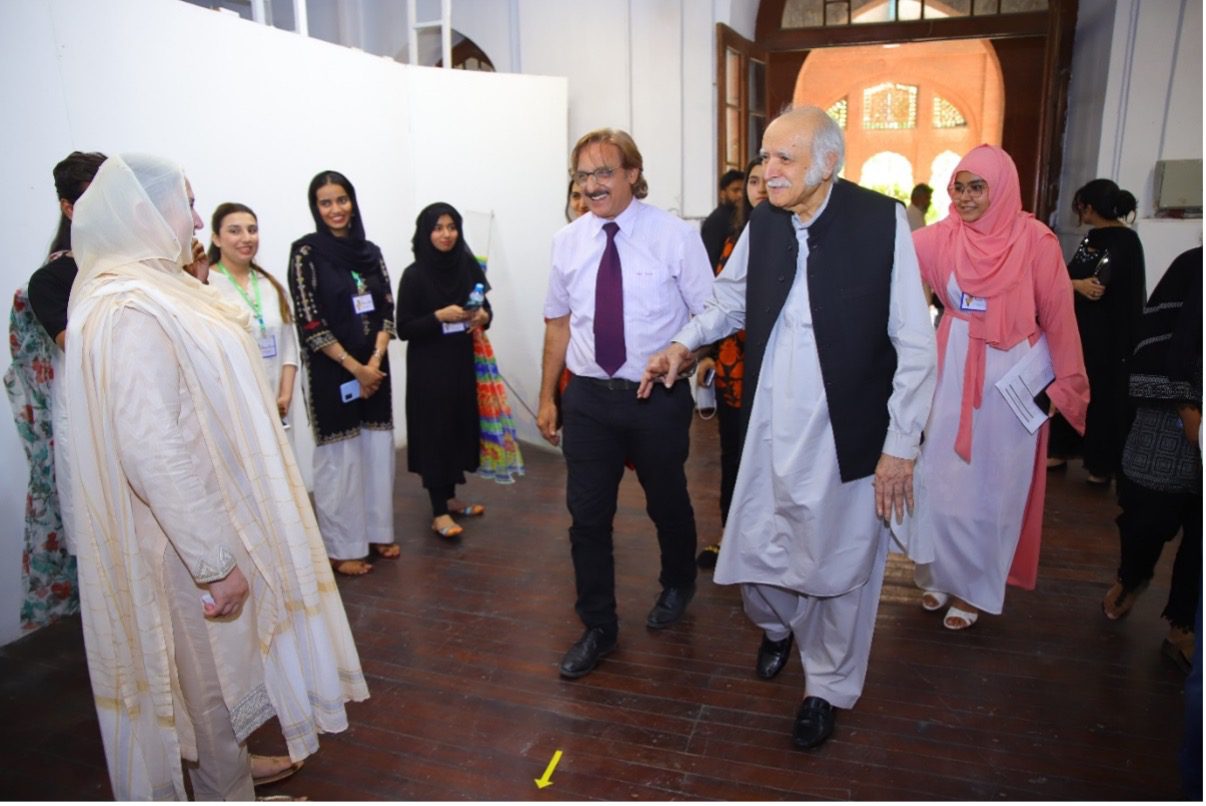
Dr. Shaukat Mahmood arriving in the Grand Hall, College of Art and Design,
University of the Punjab, Lahore.
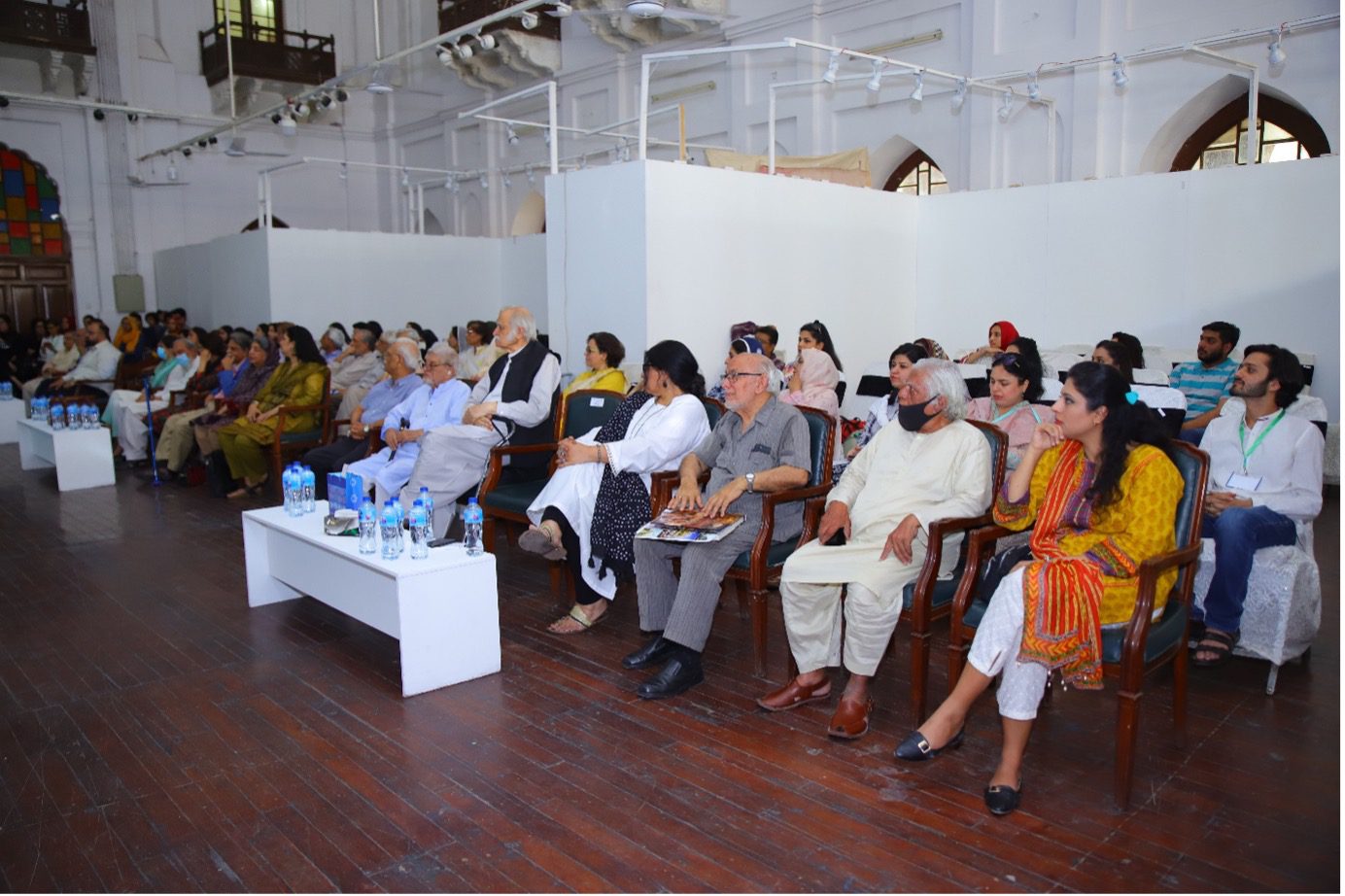
A glimpse of the audience, including notable speakers, faculty, guests and students.
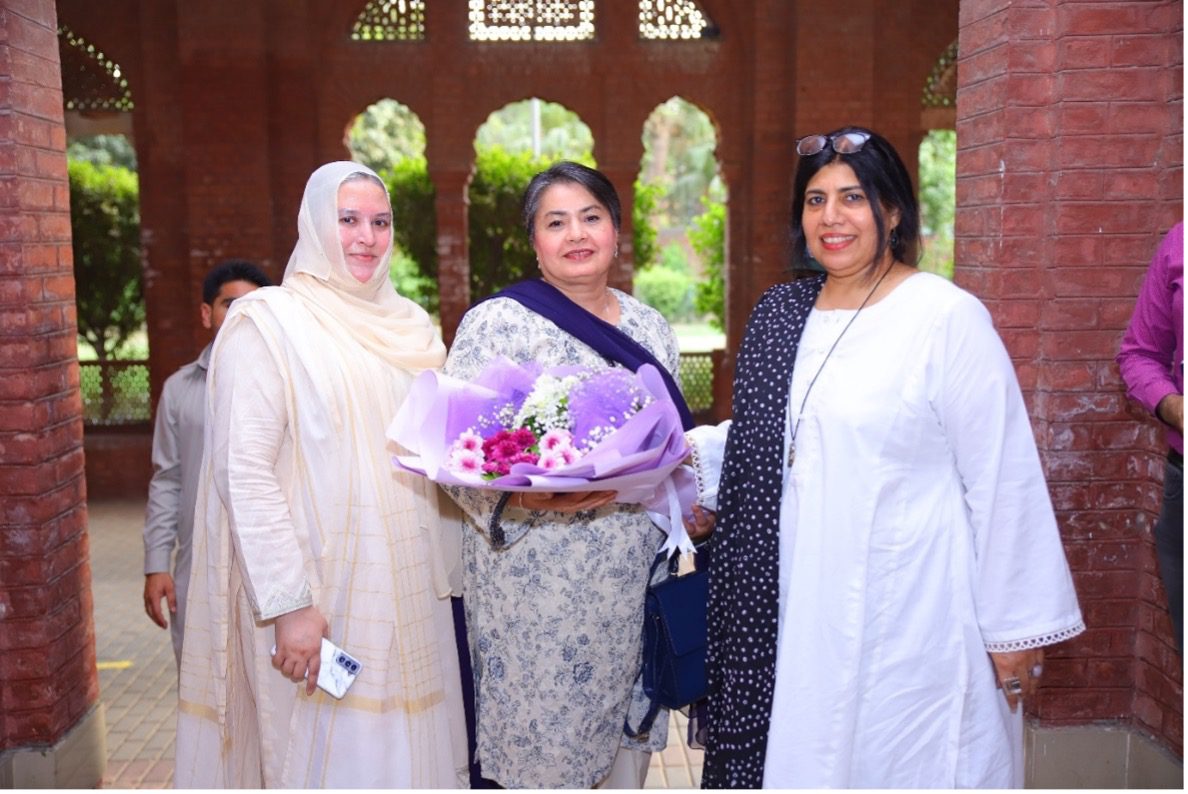
Prof. Sumera Jawad and Prof. Sarah Umer (left) receiving the
Chief Guest Prof. Kanwal Ameen.
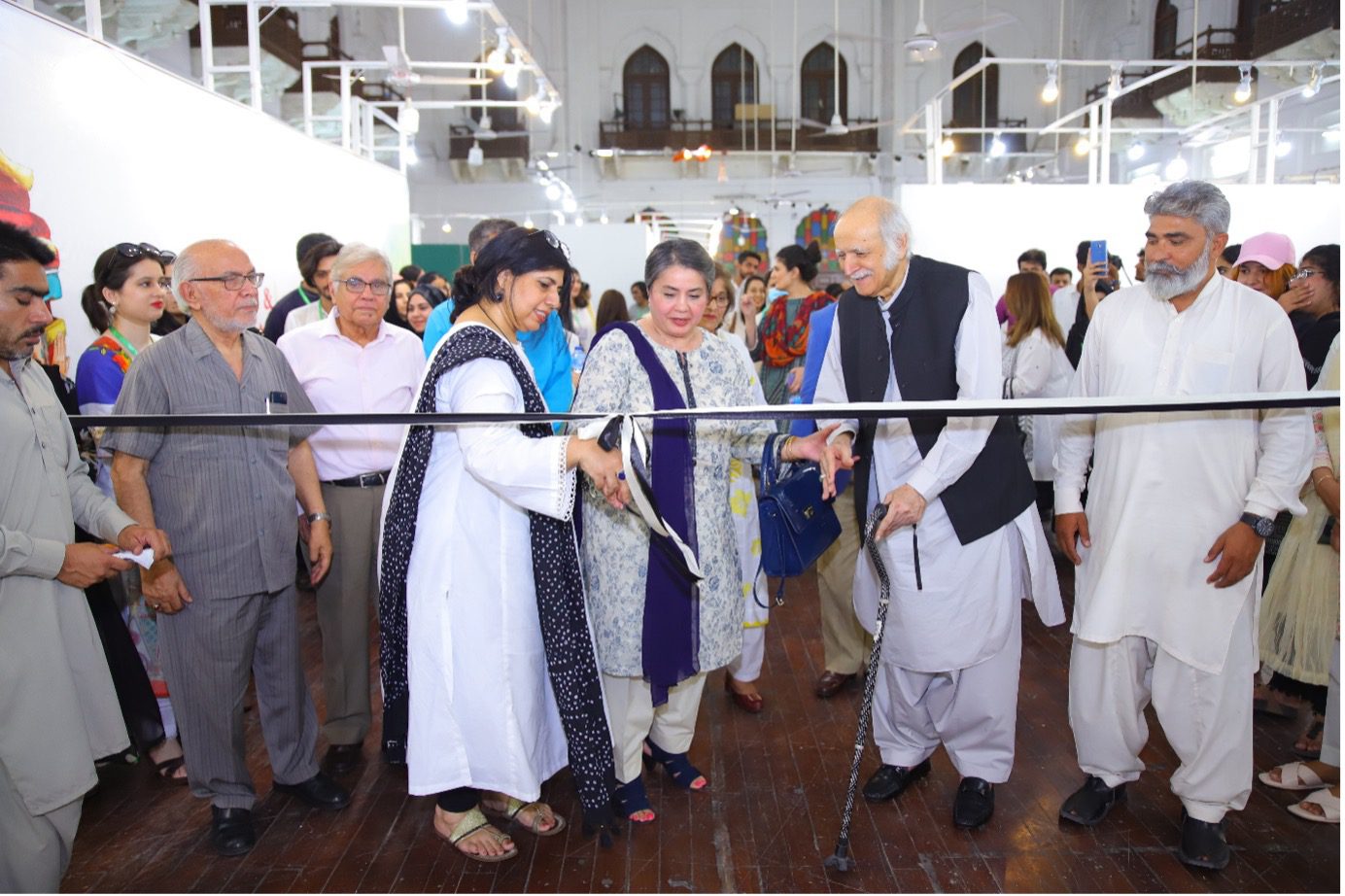
Opening of the Exhibition by Chief Guest Prof. Kanwal Ameen, Vice Chancellor Home Economics University, Lahore with Prof. Shaukat Mahmood, Prof. Sumera Jawad, Dr. Saifur Rehman Dar and others.
Another was held on October 14, 2022, on the Seven Decades of Painting of Mian Ijaz ul Hassan. The exhibited work was based on Hassan’s selective work spread over seven decades and was especially prepared for the benefit of the students and scholars. The work predominately represents his impression of people, society and the prevailing circumstances that surround us.
The seminar was divided into five segments highlighting the distinct facets of Hassan’s quest over the decades. These segments included his Early Life, His Contribution as a Painter, His Contribution as a Writer and Poet, His Contribution towards the Art Community, and finally His Contribution as a Thought-provoking Artist. Although the seminar was presided by the MPhil scholars, renowned artists and scholars were invited to shed further light on Hassan’s quest. These included Fakir Syed Aijazuddin, Shahnawaz Zaidi, Dr. Syed Akmal Hussain, Amna Pataudi, and Chaudhry Aitzaz Ahsan.

A glimpse of the audience, including Mian Ijaz ul Hassan, Prof. Musarrat Hasan, Fakir Syed Aijazuddin, Shahnawaz Zaidi, Dr. Syed Akmal Hussain, Amna Pataudi, Chaudhry Aitzaz Ahsan, faculty, guests and students.
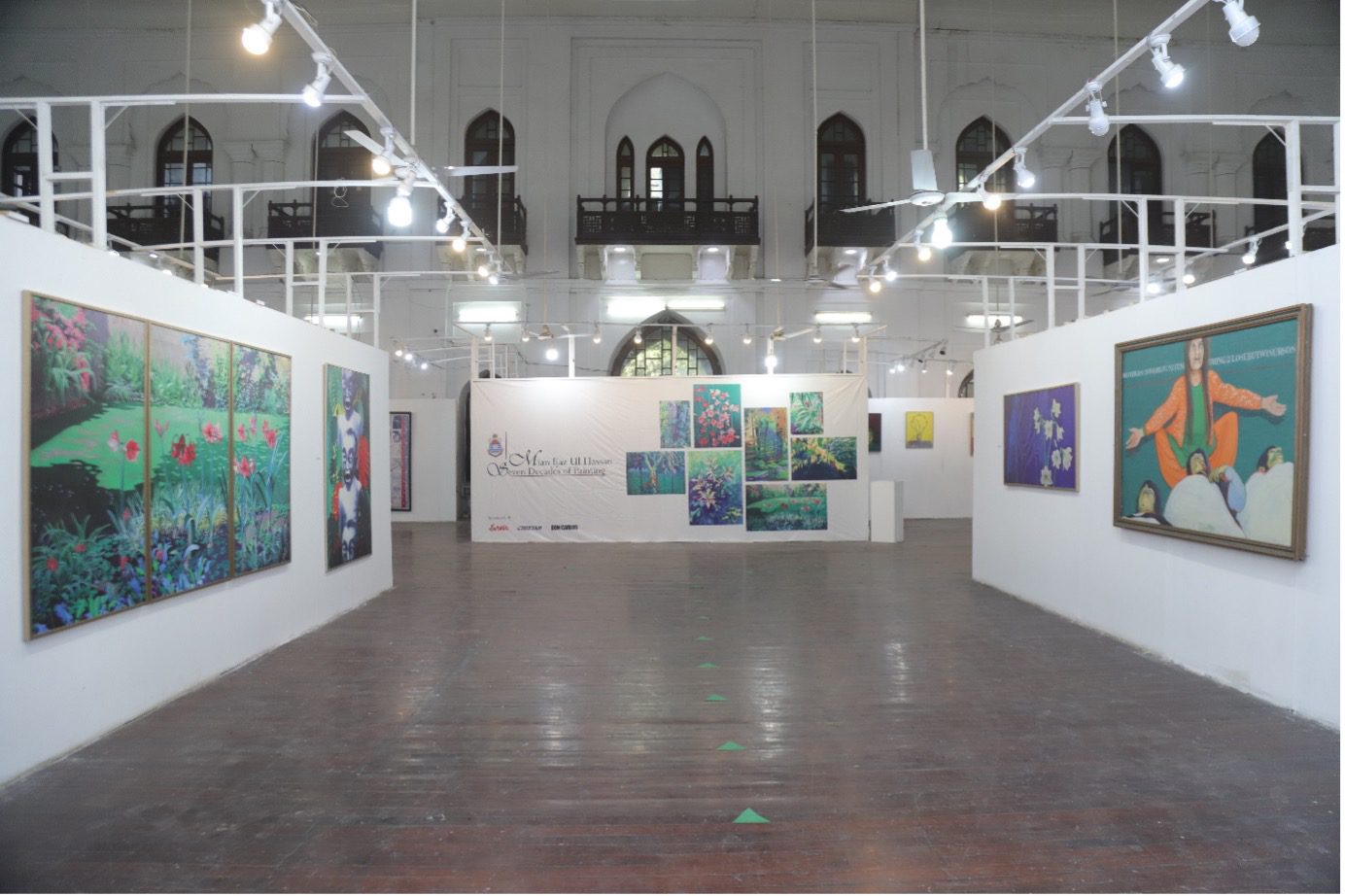
A glimpse of Grand Hall, College of Art and Design
displaying the artworks of Mian Ijaz ul Hassan.
The main purpose behind these activities was to celebrate and document the work of these artists and to inspire the young students to achieve the impossible during their life span. For both events catalogues were printed and are also digitally available on the College website.
Moreover, as my area of specialization is South Asia, I prefer to take those students under my supervision who are working on topics related to South Asian art history. Two MFA designers Umaima Mohsin and Humna Qais executed their thesis under my supervision in which a website entitled, “Culture of Punjab Pakistan” was launched on September 26, 2022, at Grand Hall, College of Art and Design during a ceremony that included a Seminar and Exhibition to celebrate and relive a few segments of the Punjabi Culture.
Several renowned Punjabi scholars including Anjum Qureshi, Ayesha Aslam, Dr Ajaz Anwar, Dr Asna Mubashra, Dr Nasir Abbas Baloch, Huma Safdar and Dr Saadat Ali Saqib, Asrar Chishti shed light on different aspects of Punjabi Culture, while other segments were covered in the form of an exhibition. The work of several artists, textile designers, calligraphers, potters, and craftsmen were displayed considering the theme.
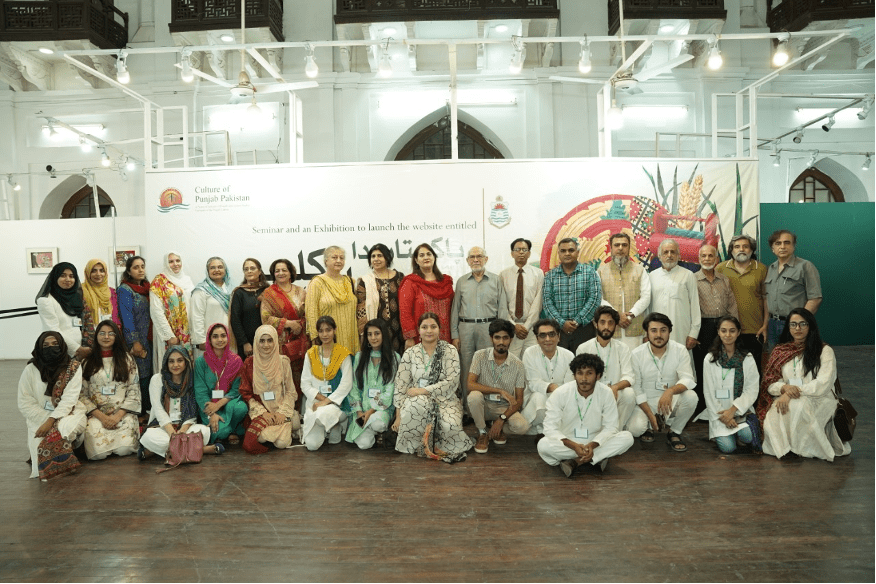
The photograph includes Dr. Saifur Rehman Dar, Prof. Sumera Jawad, Prof. Nabeela Rehman, Prof. Ahmad Bilal, Prof. Rifaat Dar, Anjum Qureshi, Ayesha Aslam, Dr. Ajaz Anwar, Dr. Asna Mubashra, Dr. Nasir Abbas Baloch, Huma Safdar and Dr. Saadat Ali Saqib, Asrar Chishti, faculty and students..

Opening of the Exhibition by Chief Guest Dr. Saifur Rehman Dar, Former Director Lahore Museum with Prof. Nabeela Rehman, Prof. Sumera Jawad, faculty and students.
☆ The views represented herein are those of the interview subjects and do not necessarily reflect the views of LMSAI, its staff, or its steering committee.
